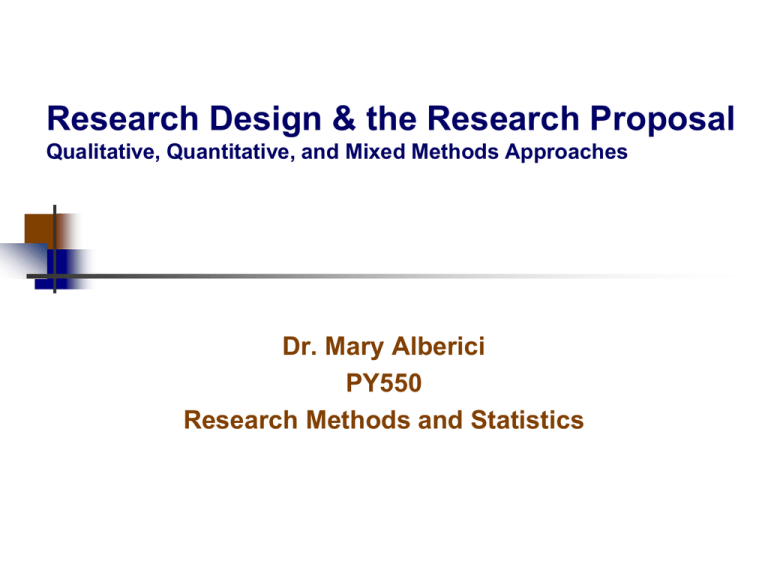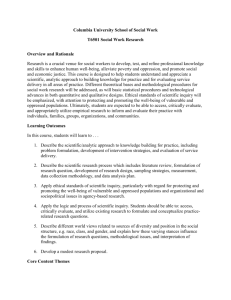The Research Proposal
advertisement

Research Design & the Research Proposal Qualitative, Quantitative, and Mixed Methods Approaches Dr. Mary Alberici PY550 Research Methods and Statistics The Three Types of Designs Three types Qualitative research Quantitative research Mixed methods research Research design Plan or proposal to conduct research Intersection of: Philosophical worldviews Strategies of inquiry Research methods Four Worldviews for Research Post positivism Constructivism Determination Reductionism Empirical observation and measurement Theory verification Advocacy/Participatory Pragmatism Political Empowerment issue-oriented Collaborative Change-oriented Understanding Multiple participant meanings Social and historical construction Theory generation Consequences of actions Problem-centered Pluralistic Real-world practice oriented Strategies of Inquiry Quantitative Experimental designs Nonexperimental designs, such as surveys Qualitative Narrative research Phenomenology Ethnographies Grounded theory studies Case study Mixed Methods Sequential Concurrent Transformative Research Methods Quantitative Methods Pre-determined Instrument-based questions Performance, attitude, observational, and census data Statistical analyses Statistical interpretation Mixed Methods Both pre-determined and emerging methods Both open- and closed-ended questions Multiple forms of data drawing on all possibilities Statistical and text analyses Across databases interpretation Qualitative Methods Emerging methods Open-ended questions Interview, observation, document, and audiovisual data Text and image analyses Themes, patterns interpretation Research Designs as Worldviews, Strategies, and Methods Tend to or typically... Qualitative Approaches Quantitative Approaches Mixed Methods Approaches Use these philosophical assumptions Constructivist/ Advocacy/ Participatory knowledge claims Post-positivist knowledge claims Employ these strategies of inquiry Phenomenology, grounded theory, ethnography, case study, & narrative Surveys & experiments Employ these methods Open-ended questions, emerging approaches, text or image data Closed-ended questions, predetermined approaches, numeric data Pragmatic knowledge claims Sequential, concurrent, & transformative Both open- and closed-ended questions, both emerging and predetermined approaches, & both quantitative and qualitative data and analysis Research Designs as Worldviews, Strategies, and Methods (cont.) Tend to or typically... Qualitative Approaches Quantitative Approaches Mixed Methods Approaches Use these practices of research, as the researcher Positions him- or herself Collects participant meanings Focuses on a single concept or phenomenon Brings personal values into the study Studies the context or setting of participants Validates the accuracy of findings Makes interpretations of the data Creates an agenda for change or reform Collaborates with the participants Tests of verifies theories or explanations Identifies variables to study Relates variables in questions or hypotheses Uses standards of validity and reliability Observes and measures information numerically Uses unbiased approaches Employs statistical procedures Collects both quantitative and qualitative data Develops a rationale for mixing Integrates the data at different stages of inquiry Presents visual pictures of the procedures in the study Employs the practices of both qualitative and quantitative research Criteria for Selecting a Research Design The Research Problem An issue or concern that needs to be addressed (see Chapter 5) If the problem calls for Personal Experiences Explanation or theory testing: Quantitative Exploration or understanding: Qualitative One approach alone is inadequate: Mixed methods Training, preferences, time, resources Audience Advisors, journal editors, graduate committees, etc. The Research Proposal Introduces the Research Problem or Question Reviews Existing Literature on Topic Outlines Proposed Methodology or Procedure Explains How the Acquired Data will be Analyzed or Interpreted Shows the Importance and Significance of the Proposed Research Addresses Anticipated Outcomes and Relevance to the Larger Community Appendices Should include Examples of Letters of Inquiry used to Recruit Sample Population Should include Examples of Letters of Informed Consent for Participants Should include Examples of Instruments or Data Gathering Tools Should include Examples of Any Other Materials that will be Used to Conduct Research May also Include Estimates for Budget, Staffing, and Equipment Needs Ethical Considerations Finally, all Internal Revue Boards (IRBs) require that each research proposal must include evidence of compliance with Human Subjects Review Guidelines, in the form of a certificate of completion from the National Institutes of Health’s “Protecting Human Research Participants” Online Training. This online course is free of charge, and can be completed by registering at the NIH website: http://phrp.nihtraining.com/index.php








